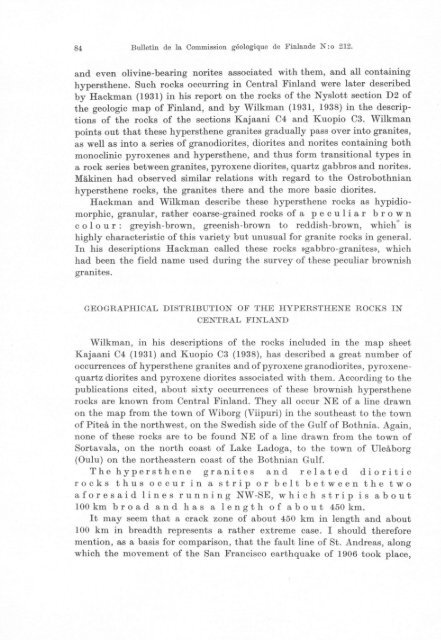COMMISSION GEOLOGIOUE - Arkisto.gsf.fi
COMMISSION GEOLOGIOUE - Arkisto.gsf.fi
COMMISSION GEOLOGIOUE - Arkisto.gsf.fi
You also want an ePaper? Increase the reach of your titles
YUMPU automatically turns print PDFs into web optimized ePapers that Google loves.
84 Bulletin de la Commission geologique de Finlande N: 0 212.<br />
and even olivine-bearing norites associated with them, and all containing<br />
hypersthene. Such rocks occurring in Central Finland were later described<br />
by Hackman (1931) in his report on the rocks of the Nyslott section D2 of<br />
the geologie map of Finland, and by Wilkman (1931, 1938) in the descriptions<br />
of the rocks of the sections Kajaani C4 and Kuopio C3. Wilkman<br />
points out that these hypersthene granites gradually pass over into granites,<br />
as weIl as into aseries of granodiorites, diorites and norites containing both<br />
monoclinic pyroxenes and hypersthene, and thus form transitional types in<br />
a rock series between granites, pyroxene diorites, quartz gabbros and norites.<br />
Mäkinen had observed similar relations with regard to the Ostrobothnian<br />
hypersthene rocks, the granites there and the more basic diorites.<br />
Hackman and Wilkman describe these hypersthene rocks as hypidiomorphic,<br />
granular, rather coarse-grained rocks of a pe c u I i a r b r 0 w n<br />
co I 0 ur: greyish-brown, greenish-brown to reddish-brown, which is<br />
highly characteristic of this variety but unusual for granite rocks in general.<br />
In his descriptions Hackman called these rocks »gabbro-granites», which<br />
had been the <strong>fi</strong>eld name used during the survey of these peculiar brownish<br />
granites.<br />
GEOGRAPHICAL DISTRIBUTION OF THE HYPERSTHENE ROCKS IN<br />
CENTRAL FINLAND<br />
Wilkman, in his descriptions of the rocks included In the map sheet<br />
Kajaani C4 (1931) and Kuopio C3 (1938), has described a great number of<br />
occurrences of hypersthene granites and ofpyroxene granodiorites, pyroxenequartz<br />
diorites and pyroxene diorites associated with them. According to the<br />
publications cited, about sixty occurrences of these brownish hypersthene<br />
rocks are known from Central Finland. They all occur NE of a line drawn<br />
on the map from the town of Wiborg (Viipuri) in the southeast to the town<br />
of Piteä in the northwest, on the Swedish side of the Gulf of Bothnia. Again,<br />
none of these rocks are to be found NE of a line drawn from the town of<br />
Sortavala, on the north coast of Lake Ladoga, to the town of Uleäborg<br />
(Oulu) on the northeastern coast of the Bothnian Gulf.<br />
The hypersthene granites and related dioritic<br />
rocks thU8 occur in a strip or belt between the two<br />
a f 0 res a i d I i n e s run n i n g NW -SE, w h ich s tri pis abo u t<br />
100 km b r 0 a dan d ha s ale n g t hof abo u t 450 km.<br />
It may seem that a crack zone of about 450 km in length and about<br />
100 km in breadth represents a rather extreme case. I should therefore<br />
mention, as a basis for comparison, that the fault line of St. Andreas, along<br />
which the movement of the San Francisco earthquake of 1906 took place,
















